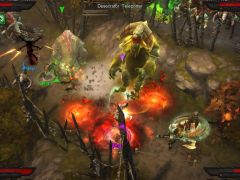Video Gamer is reader-supported. When you buy through links on our site, we may earn an affiliate commission. Prices subject to change. Learn more
Diablo 3’s release on consoles is a significant step for Blizzard. It is, after all, the first time the series has made the switch since Diablo was ported to the original PlayStation in 1998.
Diehards may declare some indefinable legitimacy is lost in translation; they may stage a Braveheart-style charge, with their ranks charging over the hill wielding flailing PC mice, led by a lunatic mounted atop a winged swivel chair. As likely as that is – well, on forums at least – it’s not necessary: the game’s essence is completely intact. To adequately make the jump from PC to console, Blizzard has implemented a number of changes, namely the overhaul of the user interface and the inclusion of some gamepad-friendly mechanics such as the ability to dodge attacks using the right thumbstick.
The quick-fire combat against hordes of enemies is well served by the pad. Different attacks and abilities are assigned to specific buttons and, although they can’t be personalised with different layouts, the way they’re mapped is efficient. Rather than assigning an attack to every button from the offset, you’re granted two at the beginning with the rest unlocked at increasing experience levels. This serves the dual purpose of allowing your character’s prowess to build alongside your own dexterity.
Defensive manoeuvres are vital to success against special enemies or bosses, and mainly comprise well-timed dodges. A flick of the right thumbstick enables your character to flip out of harm’s way so you can strike back at your aggressor, who will often be vulnerable just after attacking. This also presents an effective way to deal with swarming foes, as you can employ a rapid hit-and-run strategy to quickly thin out the pack. This ability feels organic; something your character should be able to do, and the combat is all the better for its inclusion. Despite hordes of adversaries assailing you and your party onscreen at once, the frame rate never drops and the game runs smoothly.
The user interface has essentially been redesigned from scratch around the pad, with the keyboard and mouse-led version being deemed insufficient for the console port. Your inventory, skills, party, quests and lore menus are easily navigated with the thumbsticks and shoulder buttons. Equipped items, armour and weaponry are swapped with the tap of a button, allowing you to quickly alter your preferred load-out in moments. As there’s a constant stream of incoming collected items, it can be difficult to automatically know which to assign in favour of another. Thankfully, you’re easily able to compare the stats and attributes of any potential item to the one you’re currently using whilst viewing the inventory.
You’re given the option to take a follower, the Sean Bean-inspired Templar, with you early on and you can either stick with him or trade him for another at future points in the game. Rather than being annoying or a hindrance, as various games’ companions often are, here they’re an asset. They’ll get fully stuck in during battle and offer you aid via their skills and abilities. You can control their load-out; (although some of it is predetermined), and select which special abilities they’ll employ; usually a choice between offense and defence. If their health is depleted to zero, they won’t die but instead go out of action for a short period before returning to the fray. Your follower gains experience and levels up as they go – increasing in effectiveness alongside you rather than becoming a burden as you advance.
Navigating Sanctuary is clear and straightforward, with shrouded areas of the map becoming permanently visible once you’ve explored them. The location map is accessed by pressing the D-Pad and is an invaluable tool as you progress through dungeon after dungeon. Different locations can be quickly accessed through waypoint portals, which allow you to fast-travel to any of the places you’ve discovered by selecting their name from the pop-up list, with your current desired area highlighted by an exclamation point. This convenient mechanic saves you having to retrace your steps over virtual miles you’ve already explored. Besides this, the waypoints make flitting back between two points in Sanctuary, for instance if you need to repair your equipment mid-quest, as swift as a scurrying arachnid.
A further difference between the PC and console version is that the need for an always-on internet connection has been waived for this iteration. Although this opens the game up to a wider audience, it does mean the PC version’s auction house has not made the jump, as Blizzard wouldn’t have been able to validate item transactions and sort out potential problems without a connection. Despite not having the option to trade via the auction house with in-game gold or real money, players are still able to share and trade items with friends – but this doesn’t hugely impact the game. The inclusion of a same screen co-op mode for up to four players is a masterstroke as this is the perfect game to drop in and out of should any player need to, as the rest of the party can continue and even hoard items for the vacated character.
This is about as successful a port as any Diablo fan could hope for and one that, in some areas, improves on the PC version. It’ll be interesting to see if any of the console’s innovations are ported back to the PC version in future updates.

/https://oimg.videogamer.com/images/2c00/diablo_3_164.jpg)